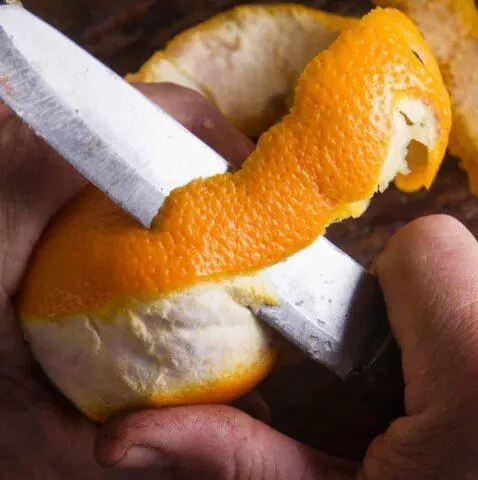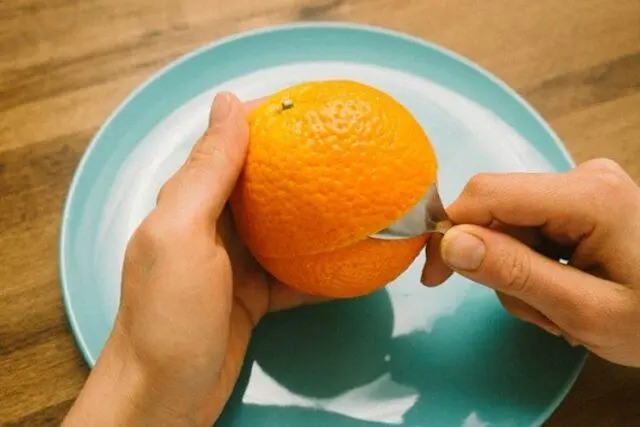Contents
Orange combines a bright refreshing taste with a rich chemical composition and health benefits. This citrus is very popular as a dessert and an independent dish, but it is not always possible to serve it beautifully. Often there are difficulties in peeling an orange without damaging the pulp and without staining the juice. In fact, there is nothing complicated about this if you choose the right citrus and follow the step-by-step instructions.
Selecting and preparing an orange
The easiest way to peel a ripe fruit. Its ripeness is evidenced by a smooth peel of a monochromatic rich orange color, without spots and “blotches” of other shades. In pale and greenish oranges, the peel is very tight to the pulp, it is almost impossible to peel them without splashing juice. The same can be said about citrus fruits with “wrinkled” and “bumpy” rinds.
Another criterion by which they evaluate how easy it will be to peel an orange is its weight. When it is obviously heavier or lighter than citrus fruits of the same size, it is better not to buy. In the first case, the pulp has clearly begun to rot and turn into an unappetizing gruel, in the second it has dried up and lost its juiciness.

Unripe, overripe, spoiled oranges not only taste much better, they are also difficult to peel.
Preparing an orange before peeling it is an optional step. But some believe that after it the process is easier, and the pulp becomes juicier. Citrus is untwisted on a cutting board, table top, other horizontal surface for 10-15 seconds, slightly pressing, but not pressing with an open palm.
How to quickly and easily peel an orange
There are several ways to peel an orange quickly, simply and accurately. But some of them require additional “devices”, so they are not always resorted to.
How to peel an orange quickly and without splashing
When the aesthetics of the result does not play a special role, you can peel the citrus with any knife with a fairly thin and sharp blade, leaving white films on the slices and part of the dense “layer” between them and the zest. To do this, first cut off the “bottom” and “lid” at the stem. The remaining crust should ideally be removed with one solid tape, but this does not always work out, especially in the absence of practice. There is nothing wrong with peeling an orange by cutting off the peel in several strips.
The fetus is held in the hands and gradually rotated. They move in a spiral, removing with a knife not only the zest, but also as much of the white layer under it as possible. The approximate thickness of the “cut” is 2-4 mm. Potatoes are peeled in the same way, so everyone has the necessary “basic skill”.

They eat an orange, cut into small slices and, as it were, “turning out” each, while simultaneously removing the remnants of the white layer under the peel
How to quickly peel an orange from a film
The white film on the slices makes the orange more “unsightly”. Some even consider it unsuitable for food. But it is inconvenient to remove it manually from each slice – it takes a lot of time, the pulp is damaged.
To peel an orange quickly, without splattering juice and without getting your hands dirty, you will need a sharply sharpened knife with a fairly thin blade, without a rounded tip, and a flat plate, dish or cutting board.
The action algorithm is simple:
- Wash and dry hands and orange thoroughly.
- Cut off the “bottom” and “lid”, creating a “flat” in the form of a circle with a diameter of 2-3 cm. This will provide the citrus with the necessary stability. Also, this operation allows you to estimate the thickness of the crust in order to minimize the impact on the pulp in the process.
- Put the citrus on a plate or other horizontal surface. Moving in a circle and from top to bottom in layers 2-2,5 cm wide, remove the peel and the layer under it. At the same time, this method allows you to clean citrus from white films. The sharper and thinner the blade of the knife, the less juice is released in the process.
- Carefully lay the fruit on its side and cut each slice in sequence, running the tip of the knife blade between the white film and the pulp.

If you peel an orange with a knife, the resulting “fillet” is very suitable for decorating pastries and other desserts.
How to peel an orange without a knife
A “basic” method that allows you to peel an orange without any additional tools. The quality of the citrus plays a big role here. It is problematic to manually peel fruits with both very thick and especially thin peels, which are clearly unripe. And for oranges with a shriveled, dried-out skin without noticeable damage to the pulp and juice splashing, this is almost impossible.
Keeping your hands clean, trying to peel a citrus without a knife and other tools will not work. With any mechanical damage to the zest, it releases a “juice” saturated with essential oils and “responsible” for the characteristic aroma. If you peel a lot of fruit at once, it even stains the fingertips and nail holes in a pale yellow color. Moreover, getting rid of an unwanted shade is not easy – you have to wash your hands at least 3-4 times.
How to properly peel an orange by hand, without a knife and other devices:
- Scald citrus with boiling water, wipe dry. After that, if you wait a couple of minutes, it will be easier to clean it – the peel will begin to lag behind the pulp.
- With the nail of the thumb or index finger (as it is more convenient), pick up the peel at the orange stem, tear it with a sharp, but smooth and continuous movement. There it is easiest to “lift” it without damaging the pulp and without splashing with juice. Despite approximately the same thickness of the “layer”, the “reliability of fastening” of the peel to the citrus is the least here.
- A fresh and ripe orange can be peeled by removing the peel from it with one ribbon in a spiral, from the stalk to the “base”. More often it turns out to tear off individual strips or even small pieces. There is nothing wrong with this, the main thing is not to damage the pulp.
In principle, unripe oranges can also be peeled in this way. But most often, when the peel is removed, in addition to the film on the slices, there is also a fairly dense white “layer”. It is unlikely that it will be possible to remove it without damaging the pulp and without splashing juice – you will have to cut the citrus into slices with a knife and eat like that.

The procedure for cleaning citrus by hand is familiar to everyone since childhood.
How to Peel an Orange in 10 Seconds
A funny and quite effective “trick” that allows you to peel an orange really quickly (a video shot by those who practice it confirms this). But no one guarantees that at the same time it will be possible not to splash yourself and others around with juice. The aesthetics of the result is also a big question. This method is resorted to only if it is planned to eat the pulp in the near future.
The algorithm of actions is as follows:
- Wash orange and hands, dry thoroughly.
- Cut off the “lid” and “bottom”, capturing not only the peel and the white layer under it, but also a little film from the pulp to determine the position of the slices.
- With a sharp thin knife, make a longitudinal cut to the center of the citrus. Ideally, you need to hit exactly between the two slices without damaging their flesh, but this requires some practice.
- Insert the thumbs of both hands into the incision.
- With a sharp, strong enough “jerk” in different directions, as if to “turn” the orange inside out. If everything is done correctly, the result will be a series of whole, separated slices on a continuous “layer” of the peel. Something similar happens if you cut a citrus into circles, and then tear off the peel and “unfold” it into a strip.
This method of peeling an orange is not suitable for either immature or overripe citrus. In the first case, in order to “turn out” a strong peel that fits snugly to the slices, considerable efforts will have to be made, while the pulp will certainly be wrinkled. In the second, it is already soft, even with a slight pressure with your fingers, the “opening” orange will splash juice on the one who tries to peel it and those around.
How to peel an orange with a spoon
A useful life hack that allows you to peel an orange with minimal damage to the pulp. The peel is removed from it in two whole halves. Therefore, the method is in demand, for example, by gardeners who use them as “pots” for growing seedlings, housewives for the original serving of fruit salad, ice cream.
Peeling an orange with a spoon is not difficult, you don’t need long practice to develop skills:
- Make a cross cut approximately in the middle of the citrus, trying to grab only the peel and the white “layer” on it, but not the film on the slices.
- Carefully insert a teaspoon or its handle into the incision, “walk” it in a circle, separating the crust from the pulp.
- Repeat the same with the second half. If everything is done correctly, then the peel is separated from the slices almost completely, it is fastened with an orange only the remains of a white “layer” at the stalk and base.
- Remove the halves of the peel by taking the citrus in your hands and turning them in different directions.

When peeling an orange with a spoon, the risk of splattering the juice or acquiring unaesthetic yellow stains from the juice on the hands is minimized.
Conclusion
Gently and quickly peeling an orange from the peel and films is quite realistic. Step-by-step instructions will help you get acquainted with different methods in detail, videos will add clarity. In principle, the methods are suitable for any citrus, but if the aesthetics of the result is important, it is necessary to choose the right fruit.









